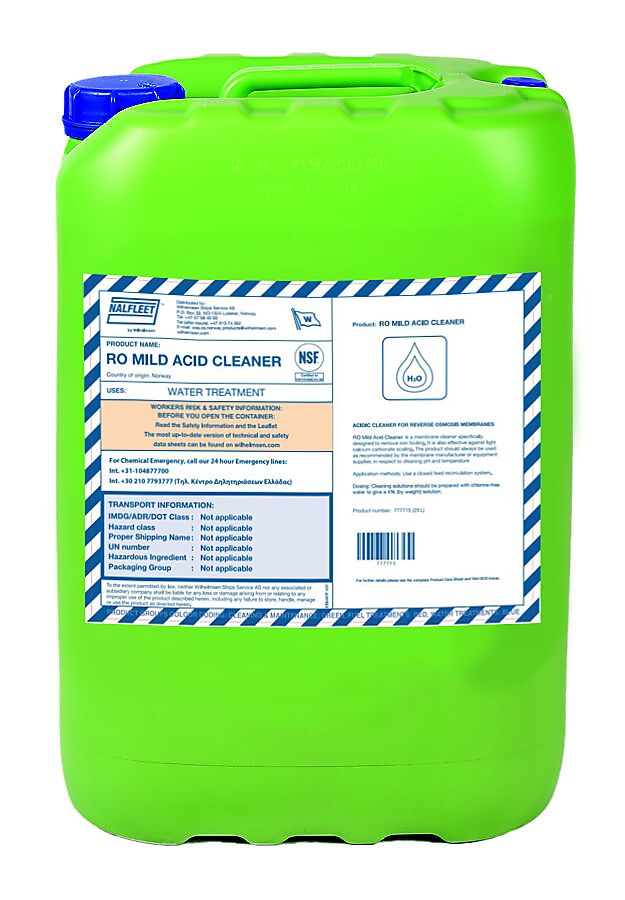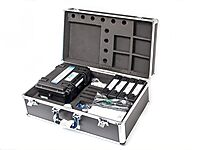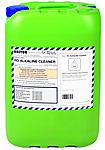


Last updated: 30/04/2025 05:19:25
RO MILD ACID CLEANER 25 LTR
Product Code
- Product group:
- 648
- Product number:
- 777715

NALFLEET™ RO Mild Acid Cleaner is a membrane cleaner specifically designed to remove fouling by iron and light calcium carbonate scaling. The efficacy of RO Mild Acid Cleaner can be enhanced by the addition of RO Alkaline Cleaner to the cleaning solution although some minor pH correction may be necessary.

Product information
This product supersedes product no: PC-77.11R, 777202
The efficacy of RO Mild Acid Cleaner can be enhanced by the addition of RO Alkaline Cleaner™ to the cleaning solution although some minor pH correction may be necessary.
Storage Instructions: RO Mild Acid Cleaner should be stored at temperature above 15 °C. Below 15 °C the product can form precipitation.
Features
- Mild acid formulation
- Compatible with wide range of RO membranes
- Liquid formulation
- Certified by NSF in accordance with Standard 60
Benefits
- Helps to maintain RO performance
- Promotes the extension of membrane lifespan
Specification
General
| Invent Hazard Material (IMO/EU) classification | C-49 |
|---|
Physical properties
| Appearance | Clear light yellow |
|---|---|
| Density [g/ml] | 1.14-1.22 |
| Form | Liquid |
| pH | 2.8 - 4.6 |
Technical data
| Not Compatible | Mild steel, Brass, Viton O-rings, Polyurethane O-rings, Vinyl ester resin, Epoxy phenolic |
|---|
Approvals
- NSF International Certifies that this product conforms to the requirements of NSF/ANSI Standard 60 - Drinking Water Treatment Chemicals - Health Effects.
- For off-line use only.
Safety Data Sheet (SDS)
Documents
Directions for use
NALFLEET™ RO Mild Acid Cleaner is a membrane cleaner specifically designed to remove iron fouling. It also is effective against light calcium carbonate scaling. The efficacy of NALFLEET™ RO Mild Acid Cleaner can be enhanced by the addition of NALFLEET™ RO Alkaline Cleaner to the cleaning solution although some minor pH correction may be necessary.
NALFLEET™ RO Mild Acid Cleaner should always be used as recommended by the membrane manufacturer or equipment supplier, in respect to cleaning pH and temperature.
During normal operation, RO membranes can become fouled, which greatly reduces the efficiency of the system. Deposits build up on the membrane until they cause a reduction in permeate flow and loss in salt rejection. The effects of fouling can lead to poor water quality, loss in production, unscheduled downtime and membrane replacement. A regular maintenance and cleaning program can provide return on investment (ROI) results ranging from 100 to 250 % by maintaining low pump output pressures and extending the membrane's life. Elements should be cleaned whenever the normalized permeate flow rate or salt rejection decreases by 10-15 % or the differential pressure increases by 10-15 % from the original baseline data.
NALFLEET™ RO Mild Acid Cleaner conforms to the requirements of NSF/ANSI Standard 60 - Drinking Water Treatment Chemicals - Health Effects.
Sampling and Testing
There is no direct test for NALFLEET™ RO Mild Acid Cleaner concentration available.
Dosing and Control
NALFLEET™ RO Mild Acid Cleaner should be fed via a closed feed system. A closed feed system is defined as a system in which fluid is moved from a closed
storage vessel into a treated media without exposure to the atmosphere except through normal venting or pressure relief devices.
Cleaning solutions should be prepared with chlorine-free product water to give a 4 % (by weight) solution, or 1 kg of NALFLEET™ RO Mild Acid Cleaner to every 25 kg of water. As NALFLEET™ RO MILD Acid Cleaner is buffered, the cleaning solution will stabilize at pH 3.6.
The cleaning time depends on the amount of fouling present but is usually completed within two to three hours. If the cleaning solution becomes red/brown in color, it must be changed as it has become exhausted. The NALFLEET™ RO Mild Acid Cleaner cleaning solution should always be neutralized with alkali and discarded after use.
Before returning the system to service, the operator must ensure that any residual cleaning product is removed from the membrane surfaces by thorough flushing. This may be done by monitoring the pH of the concentration until it returns to the same pH as the influent water.
Success Factors
Membrane fouling via deposit results in decreased production, unscheduled shutdowns, poor product water quality, and premature equipment failure.
Cleaning an RO system when required by the membrane manufacturer's operating guidelines, will make it easier to restore membrane performance and maximize its life. Allowing a membrane system to excessively foul or scale often results in the premature replacement of the membrane elements. Heavy foulant layers or scale formations can block flow channels within the elements, making it nearly impossible to get a cleaning solution to penetrate the bulk of the foulant/scale. This can result in a dramatic increase in the amount of time required for a successful cleaning, assuming it is even possible






